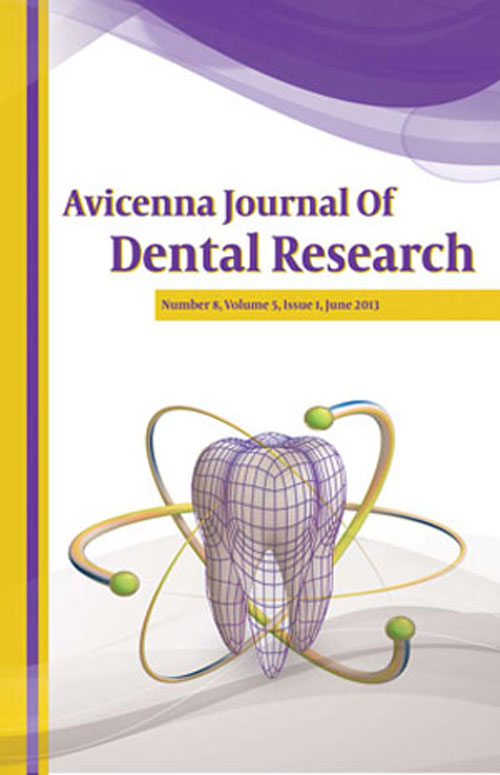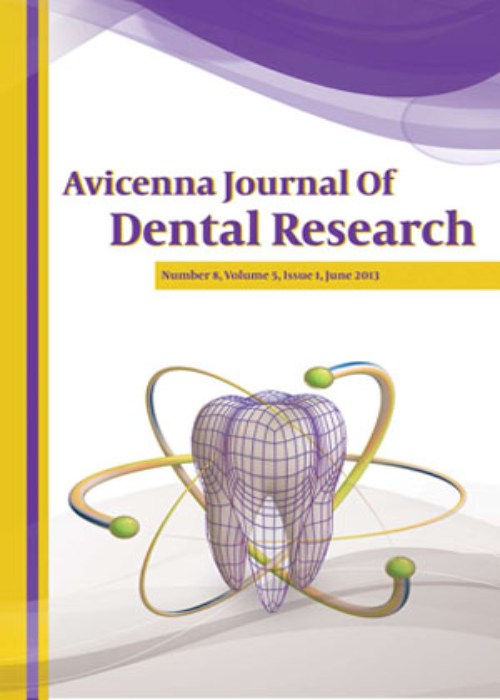فهرست مطالب

Avicenna Journal of Dental Research
Volume:10 Issue: 2, Jun 2018
- تاریخ انتشار: 1397/03/21
- تعداد عناوین: 7
-
-
Pages 38-40In comparison with oral and systemic temporomandibular joint (TMJ) medications, topical analgesics are the safest, still effective, pharmacological agents that are being used to treat temporomandibular disorders (TMDs). To select the appropriate topical agents for the treatment of various TMDs, their active ingredients and mechanisms of action should be well-understood. As for oral or systemic pharmacotherapeutics, topical analgesics can be used in combination with alternative treatments for TMDs.This review focuses on the current topical agents used in TMDs. An advanced search of publications from 2000 to 2016 was made in ScienceDirect, PubMed, Medline, and Google Scholar databases. Only English‑language articles were included in our study.Keywords: Temporomandibular disorders, Therapeutics, Review
-
Pages 42-46BackgroundTraumatic dental injuries can be considered as an important social problem because they can affect daily lives of children, and their management is a major challenge in dentistry. Therefore, the aim of this study was to determine the primary school healthcare teachers’ knowledge regarding the management of avulsed teeth in Tabriz, Iran.MethodsIn this descriptive cross-sectional study, 160 healthcare teachers were selected from Tabriz schools. A questionnaire was used to collect data on demographic characteristics and knowledge. Data were analyzed through descriptive statistics and independent t-test, using SPSS version 16.0. Statistical significance was set at P < 0.05.ResultsAmong 160 healthcare teachers, 2.5% were male and 97.5% were female. The mean age of the participants was 39.2±4.6 years. All the healthcare teachers had university education and 89.4% (143 subjects) of them had bachelor’s degrees. Of all the subjects, 96 (60%), 58 (36.2%) and 6 (3.8%) teachers had poor, moderate and good knowledge, respectively.ConclusionsThe knowledge of school healthcare teachers in Tabriz about management of avulsed teeth is inadequate. Therefore, it is suggested that appropriate training programs be provided in this area, and it is recommended that the management of dental injuries be reviewed in educational programs and other health-related topics.Keywords: Tooth Avulsion, Healthcare teachers, Elementary School, Child
-
Pages 47-51BackgroundNone of the previous studies have evaluated acrylic resin teeth used at the Dentistry Department of Hamadan University of Medical Sciences (brands: Finix, Super Berelian, and Betastar).MethodsA total of 252 samples containing acrylic resin teeth used at Hamadan Dental School were studied. Finix, Super Berelian, and Betastar were selected in the same mold and in 3 colors. (A1, A2, A3). The samples of each brand were studied in 2 groups. The first group was placed in a solution of Dentipur cleaner for 7 days. The second group of specimens was placed in 100 mL of distilled water. Data were recorded in the CIELAB system, and the spectrophotometer obtained values of ΔE, ΔL, ΔH, and ΔC. Then, changes in each of the components were obtained before and after the intervention.ResultsThe results show that the changes in the parameters of ΔE, ΔL and ΔC were statically significant when comparing the 2 groups (P < 0.05) and only in terms of the parameter ΔH, the changes were not statically significant (P > 0.05). The changes made in the variables were significantly different from the initial color of the samples in the factors ΔE, ΔL and ΔH (P < 0.001) but in terms of the parameter ΔC, the changes were not statically significant (P > 0.001), and the changes in the variables were significantly different from the sample brand in all the measured factors (P < 0.001).ConclusionsDentipur denture cleaner creates more color change than distilled water in acrylic teeth. The changes in most variables were associated with the shade of acrylic teeth, and in the teeth with brighter shade, the color change was higher compared with a darker shade. Super Berelian teeth have the most color change and Betastar teeth showed the lowest change in color. Delta E value was clinically acceptable.Keywords: Staining, Color, Denture, Teeth, Acrylic
-
Pages 52-54BackgroundReviewing the golden age of Persian traditional medicine reveals boundless descriptions of biologic, anatomic and therapeutic details of diseases. Avicenna’s al-Qanoon fi al-Teb is a precious traditional book on medicine that contains definite explanations about treatment of oral disease.ObjectivesThe aim of this study was to summarize the Avicenna’s point of views on the treatment of dental disease in comparison to modern dentistry.MethodsThe major topics of dentally related parts of al-Qanoon fi al-Teb was reviewed and compared with modern contemporary dentistry.ResultsVery interesting similarities were found between Avicenna’s methods and contemporary dental therapies. This study documented that Avicenna’s perspectives are great sources for further investigations in dentistry.ConclusionsThis research reveals unstudied parts of Avicenna’s methods in dental treatments.Keywords: Avicenna, Medicine, Persian medicine, Al-Qanoon fi al-Teb
-
Pages 55-60BackgroundOne of the main concerns of managers of different centers and institutions is the issue of employee motivation and increase of job satisfaction. Universities of medical sciences need motivated professors as educational elements to play an effective role in educating students and promoting community health and preventing the emergence of a sick and non-productive society in the future. The study aimed at investigating the motivation factors of faculty members of the School of Dentistry in Tabriz based on Herzberg’s 2-factor theory.MethodsThis cross-sectional study was conducted in Tabriz University of Medical Sciences in 2018 on 110 official and unofficial faculty members of the School of Dentistry in Tabriz that were selected according to the census. The Herzberg Job Motivation Questionnaire with 40 questions was used to collect data. Out of 110 distributed questionnaires, 87 questionnaires were returned. Data were analyzed by descriptive statistics and chi-square and Fisher exact test. P < 0.05 was considered statistically significant.Results48.3% of the individuals were female and the rest were male. Among the internal factors, the nature of the work with an average of 3.31 ± 0.42 and among external factors, occupational security with a mean of 3.47 ± 0.52 were reported as the most important factors. In sum, external factors, in comparison with internal factors, had a greater impact on employees’ motivation. By obtaining an average of 71.56 ± 17.6 out of 160, job motivation was moderate in research units. Chi-square and Fisher exact test showed that the motivating level of the studied individuals did not show a significant correlation with faculty members’ gender, marital status, academic degree and age (P > 0.05).ConclusionsThe job motivation of research units was at a moderate level. Occupational security (external factor) and the nature of the work (internal factor) had more importance.Keywords: Herzberg’s theory, Job motivation, Faculty members, School of Dentistry
-
Pages 61-64BackgroundDeep bite is one of the main common occlusal discrepancies of mixed dentition period and anterior bite plate is recommended in early mixed dentition to correct the trait and prevent the future malocclusion. The aim of this study was to assess the effect of anterior bite plate on the correction of deep bite in early mixed dentition.MethodsThis retrospective semi-experimental clinical trial was conducted on 16 patients (8 males, 8 females) with deep bite and class II malocclusion in early mixed dentition. Cephalometric radiographs were obtained from patients’ records before and after the application of anterior bite plate. Changes in 11 various angular, ratio and distance measures were evaluated by tracing the cephalograms. Collected data were then analyzed using paired t-test.ResultsStatistical differences were evaluated before and after the use of anterior bite plate appliance. Change in overbite, overjet, ANB angulation, anterior facial height, posterior facial height and Jarabak index were calculated with results indicative of significant changes (P < 0.017, P < 0.041, P < 0.001, P < 0.0001, P < 0.0001, P < 0.012). However, no significant difference in the degree of SNA, SNB, Go.Gn.SN, Y-axis and incisor to the mandibular plane angle (IMPA) was noted following the application of the appliance (P > 0.914, P > 0.219, P > 0.753, P > 0.276, P > 0.062).ConclusionsTreatment with the anterior bite plate was shown to be effective in correction of the deep bite in cases with class II malocclusion with little need for complex fixed appliance therapy.Keywords: Deep bite, Anterior bite plate, Mixed dentition
-
Pages 65-68BackgroundMast cells normally present in small numbers in the connective tissue of all organs and release a variety of potent mediators like histamine, leukotrienes, cytokines, chymase, basic fibroblast growth factor (bFGF), tryptase and heparin through degranulation.ObjectivesThe aim of the present study was the assessment of mast cell density in hyperkeratosis, dysplastic oral mucosa and oral squamous cell carcinoma (OSCC).MethodsIn this retrospective analytical study, paraffinized specimens from 15 cases of normal mucosa and 23 cases of well-differentiated OSCC, cases of hyperkeratosis and dysplasia were selected. Sections were stained with toluidine blue and then were counted at 400× magnification in hotspot areas under a light microscope. The results were analyzed using ANOVA. P values less than 0.05 were considered significant.ResultsMast cells density (MCD) increased in hyperkeratosis, dysplasia, and OSCC. There was not any significant correlation between mast cell density and hyperkeratosis, dysplastic mucosa and normal mucosa. There were significant differences between mast cell counts in SCC and normal mucosa.ConclusionsMCD is higher in hyperkeratosis and dysplastic oral mucosa than in normal mucosa. There were significant differences between mast cell counts in SCC and normal mucosa.Keywords: Mast cell, Hyperkeratosis, Dysplasia, SCC, Oral mucosa


